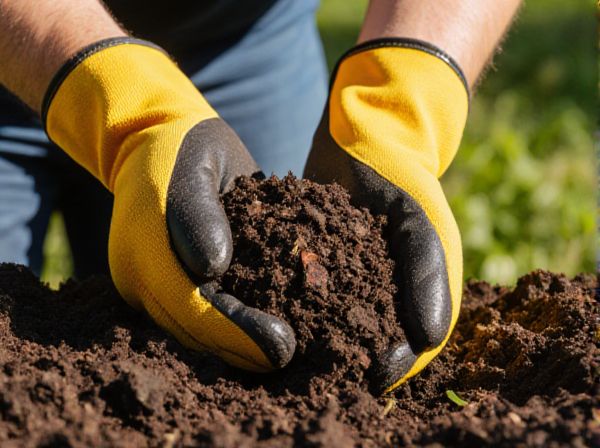
Mulching in summer vs Mulching in winter Illustration
Mulching in summer helps retain soil moisture and suppresses weeds, reducing water evaporation during hot, dry conditions. In winter, mulching provides insulation, protecting plant roots from freezing temperatures and temperature fluctuations. Choosing the right mulch type and thickness is crucial for maximizing these seasonal benefits.
Table of Comparison
| Aspect | Mulching in Summer | Mulching in Winter |
|---|---|---|
| Purpose | Retains soil moisture; reduces heat stress | Protects roots from freezing; prevents soil erosion |
| Material Effectiveness | Organic mulches cool soil; conserve water | Thicker mulch layers insulate against cold |
| Soil Temperature | Keeps soil cool and moist | Maintains steady soil warmth; prevents frost |
| Weed Control | Suppresses summer weed growth | Limits winter weed germination |
| Application Timing | Apply after soil warms (late spring/early summer) | Apply before first frost (late fall) |
| Benefits | Reduces evaporation; improves plant drought tolerance | Protects root systems; enhances soil structure |
Understanding Mulching: Summer vs Winter
Mulching in summer helps retain soil moisture, regulate temperature, and suppress weeds, crucial for preventing plant stress during hot, dry conditions. In winter, mulching primarily protects plant roots from frost, insulates soil, and prevents erosion caused by heavy rains or snow. Choosing the right mulch type, such as straw for summer warmth or wood chips for winter insulation, enhances these seasonal benefits effectively.
Key Benefits of Summer Mulching
Summer mulching helps retain soil moisture, reducing the need for frequent watering during hot, dry periods and promoting healthy plant growth. It suppresses weed growth by blocking sunlight, minimizing competition for nutrients and water in the growing season. Mulching in summer also regulates soil temperature, protecting roots from extreme heat and improving soil microbial activity essential for nutrient cycling.
Advantages of Winter Mulching
Winter mulching enhances soil insulation, protecting plant roots from freezing temperatures and minimizing frost damage. It improves moisture retention during colder months, reducing the need for frequent watering and preventing soil erosion caused by winter winds. This practice also encourages beneficial microbial activity and nutrient cycling, supporting healthier plant growth in the spring.
Soil Temperature Regulation in Different Seasons
Mulching in summer effectively reduces soil temperature by providing insulation against intense heat, which helps maintain moisture and protects plant roots from thermal stress. In winter, mulching acts as a thermal barrier that conserves soil warmth, preventing frost damage and promoting microbial activity essential for soil health. Seasonal mulching practices optimize soil temperature regulation, enhancing plant growth and resilience throughout the year.
Moisture Retention: Summer and Winter Strategies
Mulching in summer significantly enhances moisture retention by reducing soil evaporation and maintaining a cooler root zone, which is critical for plant health during hot, dry conditions. In winter, mulching acts as an insulating layer that prevents soil moisture from freezing and evaporating, thereby preserving hydration for dormant plants. Strategically adjusting mulch thickness according to the season optimizes water conservation and supports plant resilience year-round.
Choosing the Right Mulch for Each Season
Choosing the right mulch for each season enhances soil health and plant growth, with organic mulches like bark or wood chips being ideal for summer to retain moisture and regulate soil temperature. In winter, using straw or shredded leaves as mulch protects roots from freezing temperatures and improves soil structure when decomposed. Matching mulch type to seasonal needs maximizes water conservation, temperature control, and nutrient cycling throughout the year.
Application Techniques: Summer vs Winter
Mulching in summer requires thicker layers of organic material such as straw or wood chips to retain soil moisture and protect roots from heat stress, while winter mulching uses finer mulch like shredded leaves or compost to insulate soil and prevent freeze-thaw cycles. In summer, mulch should be applied around plants without smothering stems, maintaining air circulation to reduce fungal issues, whereas winter mulch layers are often spaced slightly away from plant bases to avoid rodent damage. Effective application techniques depend on seasonal temperature fluctuations and plant-specific needs, optimizing soil temperature regulation and moisture retention.
Common Mulching Mistakes in Summer and Winter
Applying mulch too thickly in summer traps heat and moisture, leading to root rot and fungal growth, while in winter, insufficient mulch coverage exposes roots to freezing temperatures and frost damage. Common mistakes include using fresh wood chips in summer, which can draw nitrogen away from plants, and failing to remove old, compacted mulch in winter, reducing soil aeration. Proper seasonal mulching balances moisture retention and temperature regulation to support plant health year-round.
Seasonal Mulch Maintenance Tips
Summer mulching requires using organic materials like straw or wood chips to retain soil moisture and regulate temperature, preventing heat stress on plants. In winter, applying mulch such as shredded leaves or bark helps insulate roots from frost and temperature fluctuations, promoting soil health and microbial activity. Proper seasonal mulch maintenance includes regular monitoring for compaction and replenishing mulch layers to ensure effective protection and nutrient preservation year-round.
Seasonal Challenges and Solutions for Mulching
Mulching in summer requires managing higher temperatures and rapid moisture evaporation, so using thicker organic mulch layers like straw or bark helps retain soil moisture and regulate soil temperature. Winter mulching focuses on protecting plant roots from freezing and temperature fluctuations, where insulating materials such as shredded leaves or straw provide effective frost protection. Seasonal challenges include preventing mulch from becoming a habitat for pests in summer and ensuring proper drainage to avoid waterlogging in winter, which can be addressed by selecting appropriate mulch types and applying them at optimal thicknesses.
Mulching in summer vs Mulching in winter Infographic

 gardendif.com
gardendif.com